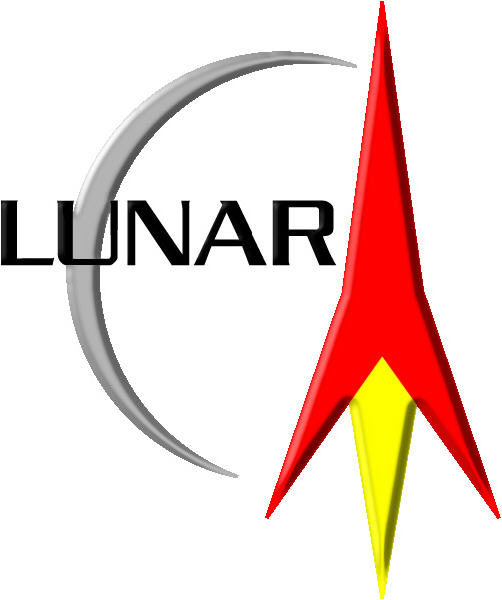 LUNAR’clips
2003
Volume 10, Number 2
LUNAR’clips
2003
Volume 10, Number 2
 LUNAR’clips
2003
Volume 10, Number 2
LUNAR’clips
2003
Volume 10, Number 2
Livermore Unit of the National Association of Rocketry March/April 2003
Copyright © 2003 by LUNAR, All rights reserved.
Based in Houston, Texas, this team, led by Dr. Norman LaFave, plans a vehicle that will take off and land on a conventional runway. The vehicle is 100 feet long; 87 foot wing span; with forked delta wings and a strake for pitch stability. The weight is 136,000 lb. at takeoff, and 120,000 lb. at rocket ignition. It is designed to carry 3 to 4 passengers in cockpit, and can carry a passenger module weighing 24,000 Lb.
The Cosmos Mariner is designed to take off from a coastal airport near Houston with its two jet engines at full throttle. After 15-20 minutes, it positions itself over open water in a stratospheric cruise (~40,000 ft, Mach 0.8), performs an initial pitch up maneuver and stabilizes for rocket ignition. The crew braces for an additional 40 tons of thrust from the rocket engine. About 130 seconds are required to burn the propellant with shutdown at 200,000 ft while traveling at Mach 7. The Cosmos Mariner continues to arc upward in free-fall, reaching apogee above 100 kilometers about 100 seconds later.
They are quoted as saying: "The aviation prizes, such as the Orteig Prize, built the aviation industry into what it is today. The competitors for the aviation prizes captured our imagination and instilled a sense of adventure in all of us which allowed aviation to grow as an industry with the support of the public. The X PRIZE, like the Orteig Prize before it, offers the spark needed to inspire the entrepreneurial spirit necessary to build this new industry and make us a true space-faring civilization."
Website: http://www.lonestarspace.com/cosmos.htm
This team, based in Fairfax, VA, and led by Len Cormier, also plans a vehicle for take off and landing on a conventional runway. They will create the SabreRocket by modifying an existing Sabre-40 jet. The Sabre-40, already certified to fly at mach 0.8 at 45,000 feet (13,716 meters), will use the existing air breathing turbojet engines only until the altitude of 11 km. At this time, the pilot will ignite a center rocket engine and start a pull-up and climb. After about 30 seconds, the pilot will start two more rocket engines, increasing the climb angle to about 50 degrees. At about 15.5 km altitude, the pilot will start the remaining four rocket engines and continue the pull-up to an 85 degree flight-path angle. At the time when all the rocket propellant is consumed, the SabreRocket will have reached a speed of mach 2.97 at an altitude of approximately 54 km.
From an altitude of 55 km and a speed of mach 2.97, it will take the SabreRocket approximately 100 seconds to coast past the 100 km altitude limit at a speed of approximately mach 0.4. The vehicle reaches the apogee of its flight at an altitude of 102 km and then begins its free fall decent. For approximately another 80 seconds, the SabreRocket descends unpowered. The total time that crew and passengers experience weightless conditions is approximately 180 seconds.
Using the attitude control system, the pilot reenters the atmosphere at an 85 or 90-degree flight-path angle and an angle-of-attack of 70 degrees. In this attitude, the wings act as a parachute or drag brake. For this phase of the flight, the wing is much more effective at generating drag than lift. This technique will minimize mach number on reentry and will also minimize the reentry g's and heating. Preliminary calculations suggest that provisions required for thermal protection during the transient heating period should be minimal. The SabreRocket will land on a horizontal runway.
They are quoted as saying "The X PRIZE provides a potentially powerful incentive for opening space to commercial competition and development. Our concept appears to be feasible with far lower investment than any of the other concepts proposed for winning the X PRIZE. Accordingly, we feel that we can offer a potentially leveraged return on investment based solely upon potential revenues from sponsors and possibly the prize money. Like the other teams, we also feel that even a good showing with respect to competing for the X PRIZE could be highly beneficial to our other plans of commercial opportunities in near Earth orbit and deep space."
Website: www.tour2space.com
All content is the responsibility of LUNAR.
If you have comments or suggestions regarding these web pages,
please contact the 
Copyright © 1992 - 2025 LUNAR